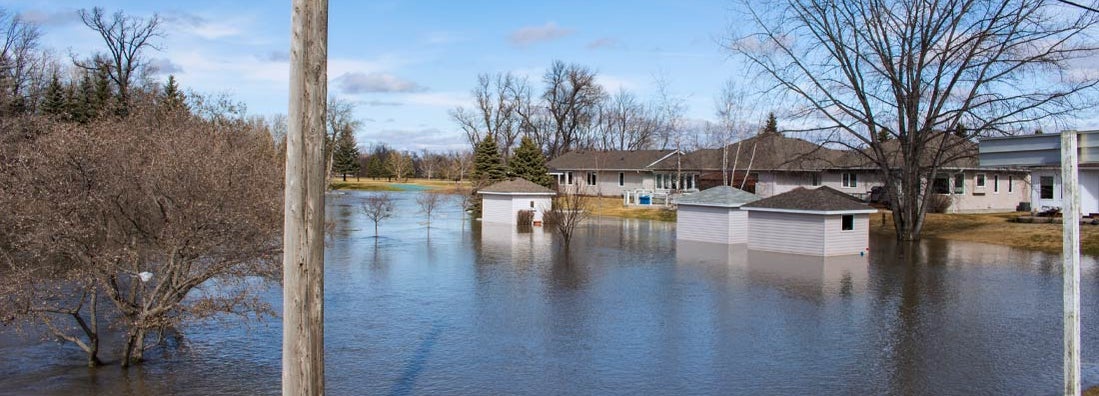Flood Insurance in Virginia
Experts break down flood insurance costs, coverages, and more in Virginia.

Jeff Green has held several positions at life insurance companies, Wall Street firms, and distribution organizations over his 40-year career.

Floods pose a serious problem in many parts of Virginia, particularly along the coastline. Unfortunately, flood damage is excluded from coverage by nearly all home, renters, and business insurance policies. If you own property in Virginia, a flood insurance policy can shield you from large flood-related financial losses.
Because independent agents live and work in your community, they understand the potential for floods in your area. These agents can help you with reviewing flood maps, assessing your risks, and buying an affordable flood insurance policy. Find an independent insurance agent near you to learn more.
What Is Flood Insurance and Why Is It Important in Virginia?
Flash floods can cause a lot of costly property damage. In fact, FEMA warns that as little as one inch of floodwater in your home can result in as much as $25,000 in property damage.
Because paying for flood damage became too expensive, many insurance companies began excluding it from the coverage provided by their home, renters, and business insurance policies in the 1950s and early 1960s.
Unfortunately, this caused a huge problem for many people in flood-prone areas because they had no way to cover their assets against flood damage. The National Flood Insurance Program (NFIP) was created in 1968 to solve this problem.
The NFIP, which is administered by FEMA, ensures that all property owners have access to guaranteed and affordable coverage against floods.
Around 10% of all properties in Virginia have at least a 26% chance of sustaining significant flood damage in the next 30 years. This constitutes nearly 400,000 homes and businesses in this state. Surprisingly, only about 103,000 of these at-risk properties are covered by flood insurance.
Having a policy can help you rest assured that if flooding impacts your area, you will not need to worry about facing large financial losses as a result.
Is Flood Insurance Required in Virginia?
Flood insurance is not required by law. However, if you live in a FEMA-designated flood zone and you are still paying on a mortgage or a home equity loan, your lender will most likely require you to carry flood insurance until you have paid off your loan in full.
If your property is located in an area with a low flood risk or if you own it outright, flood insurance is optional so the decision to carry a policy is entirely up to you.
How Much Does Flood Insurance Cost in Virginia?
The average cost of a flood insurance policy in Virginia is $772 a year. This is a very reasonable price considering the average flood claim in this state is $19,000. Rates can vary from one property owner to the next because they are based on factors like:
- Your property’s age, construction, style, and elevation
- How much structural coverage you are buying
- How much property (contents) coverage you are buying
- Your property’s assessed flood risk according to a FEMA-drawn flood map
The greater the risk that your property will sustain significant flood damage, the more your policy will cost.
What Does Flood Insurance Cover in Virginia?
Flood insurance is composed of two parts: structural coverage and contents coverage. Each of these coverage types has its own deductible, so if you are filing a claim for both types of damage, you will need to pay two deductibles.
Policies through the NFIP have different limits for individuals and businesses.
- Structural coverage: This pays to repair damage to the structure of your property, including things like its foundation, hot water heater, built-in appliances, and plumbing, electrical, and HVAC systems.
- Homeowners can purchase up to $250,000 in structural coverage.
- Businesses can purchase up to $500,000 in structural coverage.
- Contents coverage: This pays to repair or replace damaged property in the insured structure.
- Homeowners can purchase up to $100,000 in contents coverage.
- Businesses can purchase up to $500,000 in contents coverage.
You can choose to purchase one or both types of coverage in amounts that are appropriate for your specific coverage needs. If you want even more coverage than the NFIP can provide, an independent agent can help you find suitable excess flood insurance through a private insurer.
What Isn't Covered by Virginia Flood Insurance?
As with any type of insurance policy, flood insurance has some limitations. You should not expect your policy to pay for:
- Damage caused by earth movement, like landslides and mudslides
- Clean-up and remediation of mold, mildew, or moisture problems
- Personal property kept in a finished basement
- Damage to outdoor property and structures like decks, swimming pools, hot tubs, fencing, and landscaping features
- Loss or damage to currency, precious metals, or important papers
- Temporary living expenses for homeowners who must leave their homes while flood damage repairs are made
- Revenue losses experienced by businesses if they need to close while flood damage repairs are made
- Claims for damage that occurred within 30 days of your policy’s date of purchase
Be sure that you are familiar with your policy’s exclusions so that you don't face any unpleasant surprises later.
How Can an Independent Insurance Agent Help Me Get Coverage against Floods?
If you want to learn more about flood insurance, you can turn to a local independent agent for guidance and advice. These agents can answer your coverage-related questions, help you review your property’s flood risk, and, at your request, assist you with buying an affordable flood insurance policy.
There is no charge for talking to one of these experienced insurance professionals. Arrange an obligation-free consultation with an independent insurance agent near you to get started.
https://www.floodsmart.gov/
https://www.fema.gov/data-visualization/historical-flood-risk-and-costs
https://www.fema.gov/sites/default/files/2020-05/8.5x11_1_inch_flyer.pdf
https://floodfactor.com/state/virginia/51_fsid
https://nfipservices.floodsmart.gov/reports-flood-insurance-data
https://www.iii.org/fact-statistic/facts-statistics-flood-insurance
